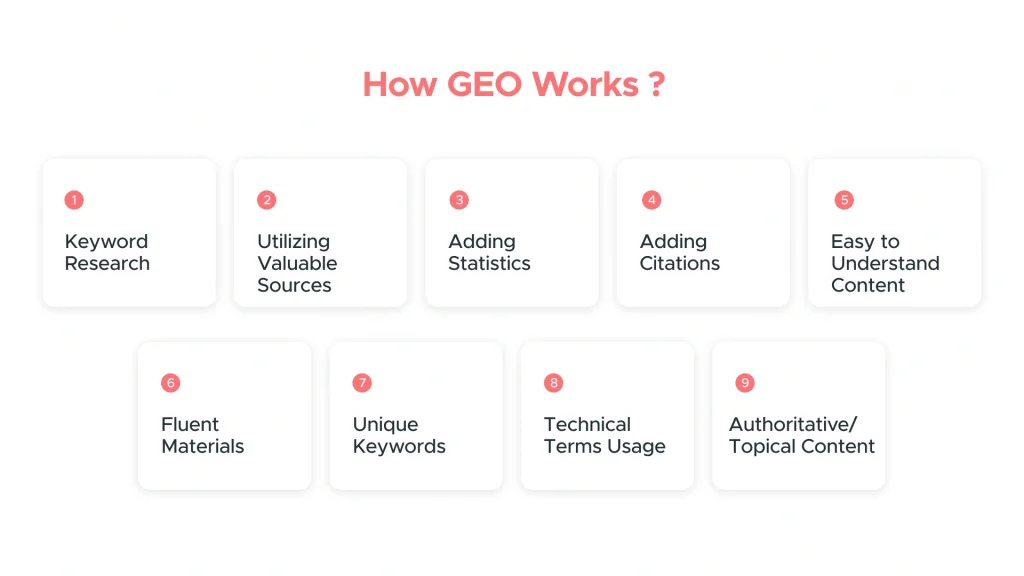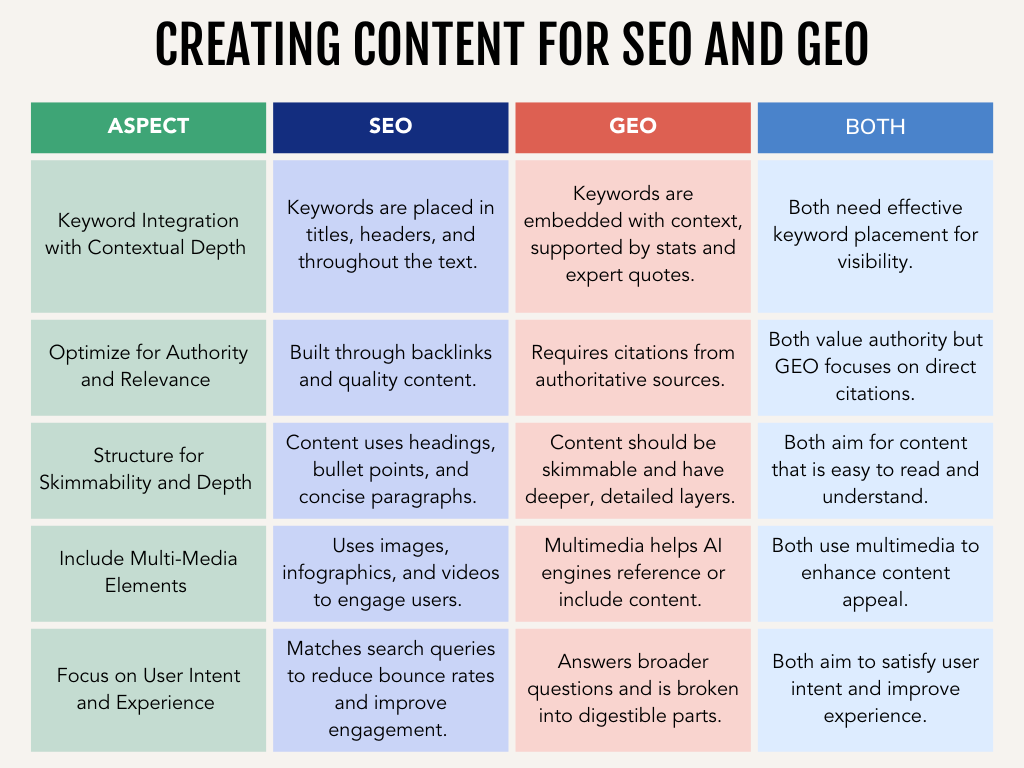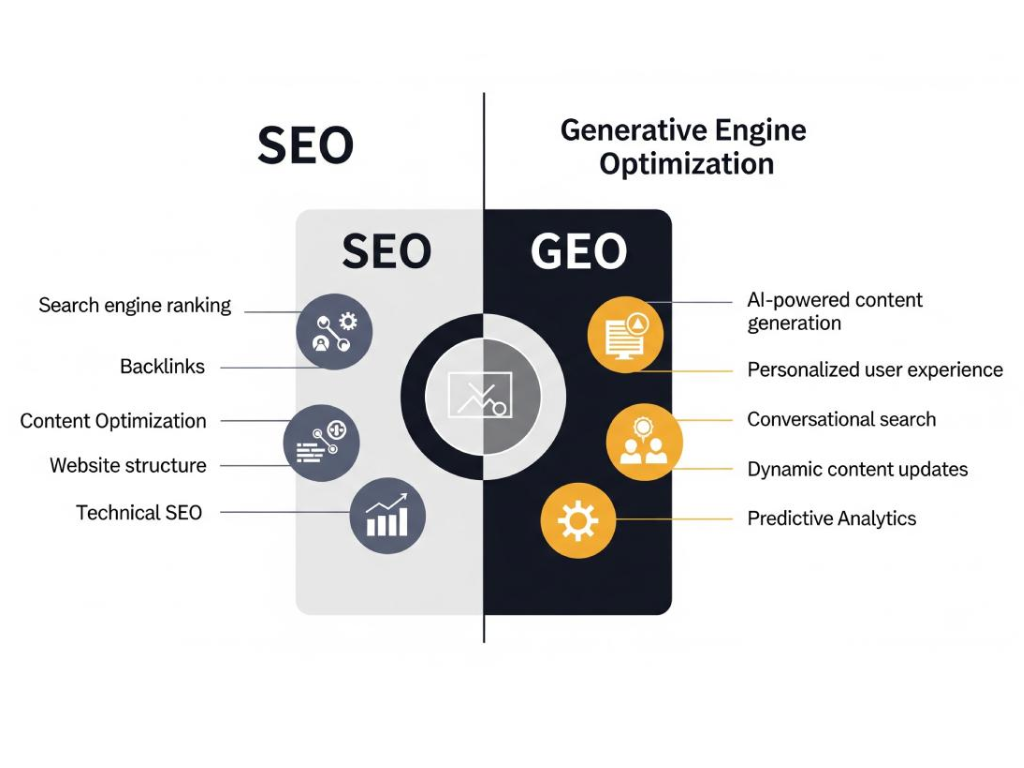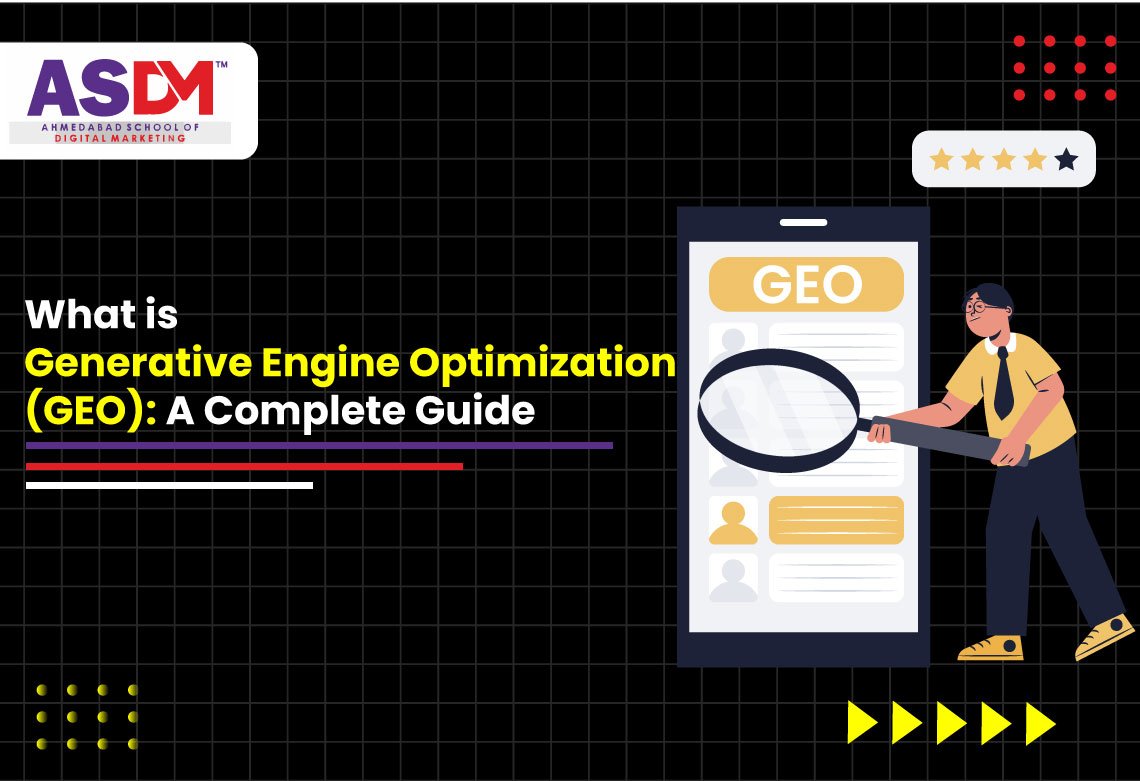In today’s digital world, where AI tools like ChatGPT, Google’s SGE, and Gemini are changing the way people search for information, a new concept is taking center stage—Generative Engine Optimization (GEO). Unlike traditional SEO, which focuses on ranking in search engine results pages (SERPs), GEO is all about optimizing your content so that it is picked up and displayed directly by AI-powered generative engines. These engines don’t just list websites—they generate answers.
So, how do you make your content visible to AI models that summarize and respond to user queries? That’s where GEO comes in. In this complete guide, we’ll break down what Generative Engine Optimization (GEO) is, how it works, and why it’s becoming essential for digital marketers, businesses, and content creators. With more users relying on AI assistants instead of traditional search engines, understanding GEO is no longer optional—it’s the future of digital visibility. Whether you’re a business owner or pursuing a Digital Marketing course in Ahmedabad, mastering GEO can give you a competitive edge in this evolving landscape.
What is GEO : Generative Engine Optimization
Generative Engine Optimization (GEO) is a new-age content optimization strategy focused on making your content discoverable and usable by AI-powered tools like ChatGPT, Google SGE (Search Generative Experience), Gemini, and other large language models (LLMs).
Unlike traditional SEO, which aims to rank your content higher on search engine result pages (SERPs), GEO is about making your content accessible, understandable, and usable by generative engines that provide direct answers to user queries.
In simple terms, GEO helps your content become the answer instead of just being a search result. When a user asks a question in an AI chatbot or a generative search platform, well-optimized GEO content can be quoted, summarized, or directly shown by these AI tools. This opens a new gateway to online visibility that’s not limited to search engines alone.
GEO is gaining massive attention in 2025 because more people are turning to AI tools like ChatGPT and Google SGE for instant answers instead of browsing through multiple search results.
Users now want quicker, more conversational responses, and generative AI is fulfilling that need. As a result, businesses and marketers are shifting their strategies to appear in these AI-generated responses.
The rise of voice search, smart assistants, and AI search engines is pushing brands to think beyond keywords and backlinks—they must now focus on context, clarity, and intent. GEO meets these needs.
Traditional SEO focuses on search rankings using keywords, backlinks, and technical improvements. GEO, on the other hand, focuses on answerability, context, and how easily AI can interpret and reuse your content.
GEO-optimized content is written in a clear, concise, and question-focused format—helping AI models fetch it directly as a source.
Why is GEO becoming popular in 2025?
GEO is gaining massive attention in 2025 because more people are turning to AI tools like ChatGPT and Google SGE for instant answers instead of browsing through multiple search results.
Users now want quicker, more conversational responses, and generative AI is fulfilling that need. As a result, businesses and marketers are shifting their strategies to appear in these AI-generated responses.
The rise of voice search, smart assistants, and AI search engines is pushing brands to think beyond keywords and backlinks—they must now focus on context, clarity, and intent. GEO meets these needs.
How is GEO different from traditional content optimization?
Traditional SEO focuses on search rankings using keywords, backlinks, and technical improvements. GEO, on the other hand, focuses on answerability, context, and how easily AI can interpret and reuse your content.
GEO-optimized content is written in a clear, concise, and question-focused format—helping AI models fetch it directly as a source.
Understanding How GEO Works and Why It Matters

Generative Engine Optimization (GEO) works by making your content easy for AI Powered Digital Marketing Course in Ahmedabad to understand, interpret, and use as part of their responses. Unlike traditional SEO, which focuses on getting clicks from search engines, GEO focuses on being selected and cited directly by AI tools like ChatGPT, Gemini, and Google’s SGE. These tools are trained to provide instant answers, and they rely on high-quality, clear, and well-structured content to do that.
GEO is about formatting your content so it’s not just readable by humans, but also by machines. It’s about writing in a way that aligns with how AI systems process language and find meaning. That includes being direct, helpful, and accurate — and answering real user questions clearly.
AI tools like ChatGPT and Gemini are at the core of GEO. These generative engines search through millions of data points and web content to give the best possible answer. If your content is structured properly and includes context-rich, question-based answers, these tools are more likely to use it.
For example, when someone asks a question in ChatGPT or Google SGE, the AI scans content across the web to generate a response. GEO ensures your content stands out as a trustworthy source that these AIs can pick and present.
How AI Content is Ranked by Generative Engines
Generative engines don’t rank content like Google’s traditional search. Instead, they prioritize:
- Clarity of language
- Relevance to the user’s question
- Trustworthiness of the source
- Structured formats like FAQs or bullet points
Content that directly answers questions and demonstrates expertise is more likely to be chosen.
Key Elements of Content Optimized for AI Bots
- Use conversational language
- Focus on search intent
- Add clear headings and subheadings
- Include FAQs
- Ensure factual accuracy
- Keep content updated
These steps help AI bots find and use your content more effectively.
GEO vs. SEO: What’s the Difference?
Aspect | SEO (Search Engine Optimization) | GEO (Generative Engine Optimization) |
Purpose | Improve rankings on search engine result pages (SERPs) | Optimize content for AI tools like ChatGPT, Google SGE, and Gemini |
Platform Focus | Google, Bing, Yahoo, and traditional search engines | AI-powered platforms and generative search engines |
User Intent | Users browse and click through links for information | Users seek direct, conversational answers from AI tools |
Optimization Focus | Keywords, backlinks, technical SEO, user experience | Clarity, context, factual accuracy, Q&A format |
Content Format | Long-form, keyword-rich, optimized for web crawlers | Short, clear, answer-focused, optimized for AI comprehension |
Traffic Source | Organic traffic from search engines | AI-assisted content visibility (no clicks needed) |
Ranking Mechanism | Based on search engine algorithms and website authority | Based on content usefulness, clarity, and AI interpretability |
Example Use Case | A blog ranking #1 on Google for “Best smartphones in 2025” | Your content quoted in ChatGPT’s response for “Top phones 2025” |
Content Discovery | Through SERP listings and site navigation | Through AI answer generation and summaries |
Ideal Strategy | Great for ongoing organic web traffic | Ideal for brand visibility in AI-generated responses |
Top GEO Strategies You Should Know
As AI tools become more integrated into how users search online, adapting your content with the right GEO (Generative Engine Optimization) strategies is crucial. Unlike traditional SEO, GEO focuses on making your content easy for AI models to read, understand, and include in their responses. Here are four key strategies to help your content get picked up by large language models (LLMs) and AI assistants.
- Optimize Content for LLMs and AI Assistants : To make your content GEO-friendly, start by writing in a clear and natural tone. Large Language Models (LLMs) like ChatGPT, Google’s Gemini, and SGE don’t just scan for keywords—they look for context and meaning. Use simple language, answer common questions, and structure content in a way that feels like a real conversation. Understanding the role of SEO is also important, as combining strong SEO practices with GEO ensures your content performs well in both search engines and AI-generated results.
- Use Structured Data and Context-Rich Answers : Structured data, like FAQ sections, bullet points, tables, and schema markup, help AI better understand the layout and purpose of your content. Also, include context-rich answers that clearly explain topics in 2–4 sentences. AI models prefer content that’s direct and informative, not vague or overly technical. Clear formatting also improves your chances of being cited in AI-generated responses.
- Focus on EEAT and User-Focused Intent : Google’s EEAT principles—Experience, Expertise, Authoritativeness, and Trustworthiness—are just as important for GEO. Make sure your content reflects genuine knowledge, trustworthy sources, and real-world experience. Always write with the user’s intent in mind. Think about what they truly want to know—and answer it directly.
- Refresh Outdated Content for AI Discoverability : AI models prefer fresh, up-to-date content. Regularly review your older posts and update them with current facts, new stats, or trends. Add relevant keywords, reformat outdated sections, and ensure all links are active.
Why GEO is Important in SEO

As the digital world continues to evolve, traditional SEO is no longer enough. Today, Generative Engine Optimization (GEO) is becoming just as important—especially with the rise of AI-driven tools. GEO helps ensure that your content is not only searchable but also visible and usable by AI assistants that generate answers instead of just listing websites. Let’s explore why GEO matters more than ever in today’s content landscape.
In 2025, AI-powered assistants like ChatGPT, Google’s Gemini, and Search Generative Experience (SGE) are changing how users search online. Instead of typing a query into Google and browsing through several pages, users now ask AI for direct answers. These assistants analyze large amounts of web content and generate clear, concise responses—without needing users to visit multiple websites. This shift in behavior has created a new opportunity for content creators: if your content is GEO-optimized, it can become the answer the AI delivers.
GEO ensures your brand’s content is structured in a way that AI models can understand and select it when generating responses. This means you’re not just competing for a spot on Google’s first page—you’re aiming to be the source behind the AI’s answer. When users see your brand name in a response from ChatGPT or Gemini, it builds instant credibility and trust.
Today’s search is no longer limited to SERPs (Search Engine Results Pages). With smart assistants, voice search, and generative engines becoming mainstream, GEO helps your content stay visible in these new spaces. Brands that adopt GEO early will have a clear advantage in reaching future-ready audiences where AI leads the conversation.
The digital marketing world is changing fast, and Generative Engine Optimization (GEO) is at the heart of this transformation. As more people turn to AI tools for answers instead of traditional search engines, GEO is becoming a must-have strategy. Understanding its future potential can help businesses stay ahead in a highly competitive space.
Rise of AI Assistants like ChatGPT, Gemini & SGE
In 2025, AI-powered assistants like ChatGPT, Google’s Gemini, and Search Generative Experience (SGE) are changing how users search online. Instead of typing a query into Google and browsing through several pages, users now ask AI for direct answers. These assistants analyze large amounts of web content and generate clear, concise responses—without needing users to visit multiple websites. This shift in behavior has created a new opportunity for content creators: if your content is GEO-optimized, it can become the answer the AI delivers.
GEO Helps Brands Appear in AI-Generated Answers
GEO ensures your brand’s content is structured in a way that AI models can understand and select it when generating responses. This means you’re not just competing for a spot on Google’s first page—you’re aiming to be the source behind the AI’s answer. When users see your brand name in a response from ChatGPT or Gemini, it builds instant credibility and trust.
GEO Increases Visibility in New Search Environments
Today’s search is no longer limited to SERPs (Search Engine Results Pages). With smart assistants, voice search, and generative engines becoming mainstream, GEO helps your content stay visible in these new spaces. Brands that adopt GEO early will have a clear advantage in reaching future-ready audiences where AI leads the conversation.
Future Potential of GEO
The digital marketing world is changing fast, and Generative Engine Optimization (GEO) is at the heart of this transformation. As more people turn to AI tools for answers instead of traditional search engines, GEO is becoming a must-have strategy. Understanding its future potential can help businesses stay ahead in a highly competitive space.
Will GEO Replace SEO Completely?
While GEO is growing rapidly, it’s unlikely to fully replace Search Engine Optimization (SEO)—at least not anytime soon. SEO will always be important for driving organic traffic through search engines like Google. However, GEO adds a new layer to content strategy. It focuses on making content accessible to AI assistants like ChatGPT, Gemini, and Google SGE. In the future, both GEO and SEO will likely work together. SEO gets you clicks from search engines, and GEO gets your brand mentioned in AI-generated answers. If you’ve been asking “What is Google AI Mode?”, understanding GEO will help you see how AI-powered search features fit into the bigger picture. It’s not about replacing—it’s about evolving.
How Businesses Can Prepare for GEO in 2026 and Beyond
To prepare for GEO, businesses should start by understanding how AI tools read and process content. Writing clear, informative answers to commonly asked questions, using structured data, and updating older content will be key steps. Brands should also pay attention to Google’s EEAT (Experience, Expertise, Authoritativeness, and Trustworthiness) guidelines to ensure their content is seen as credible—not just by people, but by AI systems as well. Investing in GEO now can give businesses a head start before it becomes a standard industry practice.
Predictions for Generative Search and AI-Driven Content
By 2026, generative search could become the primary way people look for information. AI will continue to improve at summarizing content, pulling direct answers, and personalizing results. Brands that adapt their content to fit this new model will have a major advantage. GEO will become a core skill in digital marketing, just like SEO did a decade ago.
Will GEO Replace SEO Completely?
While GEO is growing rapidly, it’s unlikely to fully replace Search Engine Optimization (SEO)—at least not anytime soon. SEO will always be important for driving organic traffic through search engines like Google. However, GEO adds a new layer to content strategy. It focuses on making content accessible to AI assistants like ChatGPT, Gemini, and Google SGE. In the future, both GEO and SEO will likely work together.
SEO gets you clicks from search engines, and GEO gets your brand mentioned in AI-generated answers. If you’ve been asking “What is Google AI Mode?”, understanding GEO will help you see how AI-powered search features fit into the bigger picture. It’s not about replacing—it’s about evolving.
How Businesses Can Prepare for GEO in 2026 and Beyond

To prepare for GEO, businesses should start by understanding how AI tools read and process content. Writing clear, informative answers to commonly asked questions, using structured data, and updating older content will be key steps. Brands should also pay attention to Google’s EEAT (Experience, Expertise, Authoritativeness, and Trustworthiness) guidelines to ensure their content is seen as credible—not just by people, but by AI systems as well. Investing in GEO now can give businesses a head start before it becomes a standard industry practice.
By 2026, generative search could become the primary way people look for information. AI will continue to improve at summarizing content, pulling direct answers, and personalizing results. Brands that adapt their content to fit this new model will have a major advantage. GEO will become a core skill in digital marketing, just like SEO did a decade ago.
Final Thoughts For GEO : Generative Engine Optimization
As digital behavior shifts toward AI-driven tools like ChatGPT, Gemini, and Google’s SGE, Generative Engine Optimization (GEO) is becoming a vital part of every content strategy. It’s no longer just about ranking on search engines—it’s about becoming the source that powers intelligent answers across platforms.
While traditional SEO remains important, GEO adds a powerful new layer that focuses on clarity, credibility, and context. It helps your content get picked by AI assistants and ensures your brand stays visible in emerging search environments. Businesses that embrace GEO now are more likely to lead the conversation tomorrow.
To stay ahead, focus on writing clear answers, updating old content, using structured formats, and building trust with readers and AI tools alike. GEO isn’t a replacement for SEO—it’s the next natural step forward. In short, if SEO gets your content found, GEO gets it featured. Adapting to this change today will help your brand stay visible, relevant, and competitive in the AI-powered future of search.
If you’re learning through a Digital Marketing course in Surat, mastering both SEO and GEO will give you a strong edge in this evolving landscape.
FAQ
Why is it called generative?
It’s called “generative” because tools like ChatGPT and Google SGE generate answers instead of showing links like traditional search engines. When understanding What is GEO?, you’ll see that it focuses on optimizing content for these generative systems. Knowing How Does GEO Work helps explain why content needs to be structured so AI can generate meaningful responses. The idea connects directly to GEO strategies, which are designed for AI-generated answers. This is Why GEO is Important in the evolving digital world.
What is a generative engine?
A generative engine is an AI tool like ChatGPT or Gemini that processes questions and generates human-like responses. Understanding What is GEO? means knowing how these engines work. How Does GEO Work depends on creating content that these engines can interpret clearly. With strong GEO strategies, your content becomes part of these generated responses. This shift in search behavior is exactly Why GEO is Important for future visibility and engagement.
What is the difference between SEO and GEO?
What is GEO? It’s the next evolution of search optimization, focused on AI-generated results. How Does GEO Work differs from SEO—GEO aims to make content easy for AI to quote, while SEO focuses on search rankings. Why GEO is Important today is because people are using tools like ChatGPT more often. The rise of GEO strategies now complements traditional SEO by preparing your content for generative platforms, not just search engines.
What are the benefits of GEO?
One key benefit of understanding What is GEO? is that it increases your brand’s chances of being featured in AI responses. When you learn How Does GEO Work, you can shape content that appears directly in ChatGPT or Gemini answers. This visibility is Why GEO is Important in today’s AI-first world. Using smart GEO strategies—like structured answers and clear formatting—improves trust, reach, and authority across generative platforms.
How to learn generative engine optimization?
To learn What is GEO?, start by exploring how generative engines process and deliver content. Study How Does GEO Work with AI tools like SGE and ChatGPT. Knowing Why GEO is Important helps you see its growing value. Focus on learning GEO strategies like writing in Q&A format, using structured data, and targeting AI-based search intent. Online courses and blogs from trusted digital marketers can guide your learning journey.
What are the disadvantages of GEO?
While What is GEO? offers many benefits, it also has challenges. One downside is that AI tools may summarize your content without driving traffic to your site. Also, learning How Does GEO Work takes time, as it’s still an emerging field. That said, understanding Why GEO is Important can help balance the risks. Smart GEO strategies can ensure your brand gets credit, visibility, and authority even if clicks are reduced.
What does GEO stand for in SEO?
In the SEO world, GEO stands for Generative Engine Optimization. Knowing What is GEO? helps you understand how AI impacts content visibility. SEO helps you rank in Google, but How Does GEO Work helps you get quoted in AI-generated answers. That’s Why GEO is Important—it gives your content a new chance to be discovered. Incorporating GEO strategies makes your existing SEO efforts more future-proof.
How to improve generative engine optimization?
To improve What is GEO?, start by answering user questions clearly and concisely. Learn How Does GEO Work by analyzing how ChatGPT or SGE generate answers. Understand Why GEO is Important in staying competitive in an AI-first digital landscape. Implement strong GEO strategies like updating old content, using headings effectively, and including relevant FAQs. Regular content audits and simplified formats also help improve GEO performance.

